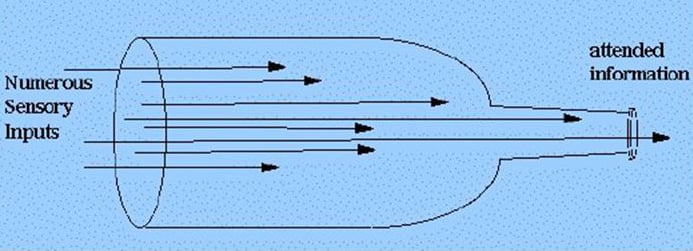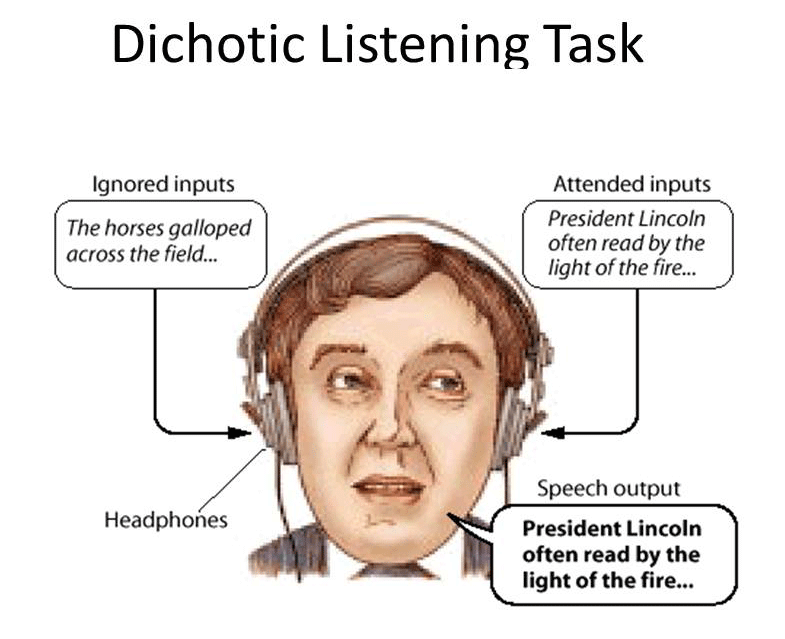An endless array of internal and external stimuli, thoughts, and emotions constantly bombards us. Given this abundance of available data, it is amazing that we make sense of anything!
In varying degrees of efficiency, we have developed the ability to focus on what is important while blocking out the rest.
What is Selective Attention?
Selective attention is the process of directing our awareness to relevant stimuli while ignoring irrelevant stimuli in the environment.
This is an important process as there is a limit to how much information can be processed at a given time, and selective attention allows us to tune out insignificant details and focus on what is important.
This limited capacity for paying attention has been conceptualized as a bottleneck, which restricts the flow of information. The narrower the bottleneck, the lower the rate of flow.
Broadbent’s and Treisman’s Models of Attention are all bottleneck models because they predict we cannot consciously attend to all of our sensory input at the same time.

Broadbent’s Filter Model
Broadbent’s Attentional Theory, also known as the Filter Theory of Attention, proposes that humans can only process a limited amount of sensory information at any given time due to an attentional “bottleneck.”
Broadbent (1958) proposed that the physical characteristics of messages are used to select one message for further processing and that all others are lost.
Information from all stimuli presented at any time enters an unlimited-capacity sensory buffer.
One of the inputs is then selected based on its physical characteristics (such as pitch or loudness) for further processing by being allowed to pass through a filter.
Because we have only a limited capacity to process information, this filter is designed to prevent the information-processing system from becoming overloaded.
The inputs not initially selected by the filter remain briefly in the sensory buffer store, and if they are not processed, they decay rapidly. Broadbent assumed that the filter rejected the unattended message at an early processing stage.
According to Broadbent, the meaning of any of the messages is not taken into account at all by the filter. All semantic processing is carried out after the filter has selected the message to pay attention to. So whichever message(s) are restricted by the bottleneck (i.e., not selective) is not understood.
Broadbent wanted to see how people could focus their attention (selectively attend), and to do this; he deliberately overloaded them with stimuli.
One of the ways Broadbent achieved this was by simultaneously sending one message to a person’s right ear and a different message to their left ear.
This is called a split-span experiment (the dichotic listening task).
Dichotic Listening Task
The dichotic listening tasks involves simultaneously sending one message (a 3-digit number) to a person’s right ear and a different message (a different 3-digit number) to their left ear.

Participants were asked to listen to both messages simultaneously and repeat what they heard. This is known as a “dichotic listening task.”
Broadbent was interested in how these would be repeated back. Would the participant repeat the digits back in the order that they were heard (order of presentation), or repeat back what was heard in one ear followed by the other ear (ear-by-ear).
He found that people made fewer mistakes repeating back ear by ear and would usually repeat back this way.
Evaluation of Broadbent’s Model
1. Broadbent’s dichotic listening experiments have been criticized because:
- The early studies all used people who were unfamiliar with shadowing and so found it very difficult and demanding. Eysenck and Keane (1990) claim that the inability of naive participants to shadow successfully is due to their unfamiliarity with the shadowing task rather than an inability of the attentional system.
- Participants reported after the entire message had been played – it is possible that the unattended message is analyzed thoroughly, but participants forget.
- Analysis of the unattended message might occur below the level of conscious awareness. For example, research by Von Wright et al. (1975) indicated analysis of the unattended message in a shadowing task. A word was first presented to participants with a mild electric shock. When the same word was later presented to the unattended channel, participants registered an increase in GSR (indicative of emotional arousal and analysis of the word in the unattended channel).
- More recent research has indicated the above points are important: e.g., Moray (1959) studied the effects of the practice. Naive subjects could only detect 8% of digits appearing in either the shadowed or non-shadowed message; Moray (an experienced “shadower”) detected 67%.
2. Broadbent’s theory predicts that hearing your name when you are not paying attention should be impossible because unattended messages are filtered out before you process the meaning – thus, the model cannot account for the “Cocktail Party Phenomenon.”
3 . Other researchers have demonstrated the “ cocktail party effect ” (Cherry, 1953) under experimental conditions and have discovered occasions when information heard in the unattended ear “broke through” to interfere with information participants are paying attention to in the other ear.
This implies some analysis of the meaning of stimuli must have occurred prior to the selection of channels. In Broadbent’s model, the filter is based solely on sensory analysis of the physical characteristics of the stimuli.
Treisman’s Attenuation Model
Treisman (1964) agrees with Broadbent’s theory of an early bottleneck filter. However, the difference is that Treisman’s filter attenuates rather than eliminates the unattended material.
Attenuation is like turning down the volume so that if you have four sources of sound in one room (TV, radio, people talking, baby crying), you can turn down or attenuate 3 to attend to the fourth.
This means people can still process the meaning of the attended message(s).
In her experiments, Treisman demonstrated that participants could still identify the contents of an unattended message, indicating that they were able to process the meaning of both the attended and unattended messages.
Treisman carried out dichotic listening tasks using the speech shadowing method. Typically, in this method, participants are asked to simultaneously repeat aloud speech played into one ear (called the attended ear) while another message is spoken to the other ear.
For example, participants were asked to shadow “I saw the girl furniture over” and ignore “me that bird green jumping fee,” reported hearing “I saw the girl jumping over.”
Clearly, then, the unattended message was being processed for meaning, and Broadbent’s Filter Model, where the filter was extracted based on physical characteristics only, could not explain these findings. The evidence suggests that Broadbent’s Filter Model is inadequate and does not allow for meaning to be taken into account.
Evaluation of Treisman’s Model
1. Treisman’s Model overcomes some of the problems associated with Broadbent’s Filter Model, e.g., the Attenuation Model can account for the “Cocktail Party Syndrome.”
2. Treisman’s model does not explain how exactly semantic analysis works.
3. The nature of the attenuation process has never been precisely specified.
4. A problem with all dichotic listening experiments is that you can never be sure that the participants have not actually switched attention to the so-called unattended channel.
References
Broadbent, D. (1958). Perception and Communication. London: Pergamon Press.
Cherry, E. C. (1953). Some experiments on the recognition of speech with one and with two ears. Journal of the Acoustical Society of America, 25, 975–979.
Eysenck, M. W. & Keane, M. T. (1990). Cognitive psychology: a student’s handbook. Hove: Lawrence Erlbaum Associates Ltd.
Moray, N. P. (1959). Attention in dichotic listening: Affective cues and the influence of instructions. Quarterly Journal of Experimental Psychology, 11, 56–60.
Treisman, A., 1964. Selective attention in man. British Medical Bulletin, 20, 12-16.
Von Wright, J. M., Anderson, K., & Stenman, U. (1975). Generalization of conditioned GSRs in dichotic listening. In P. M. A. Rabbitt & S. Dornic (Eds.), Attention and performance (Vol. V, pp. 194–204). London: Academic Press.

